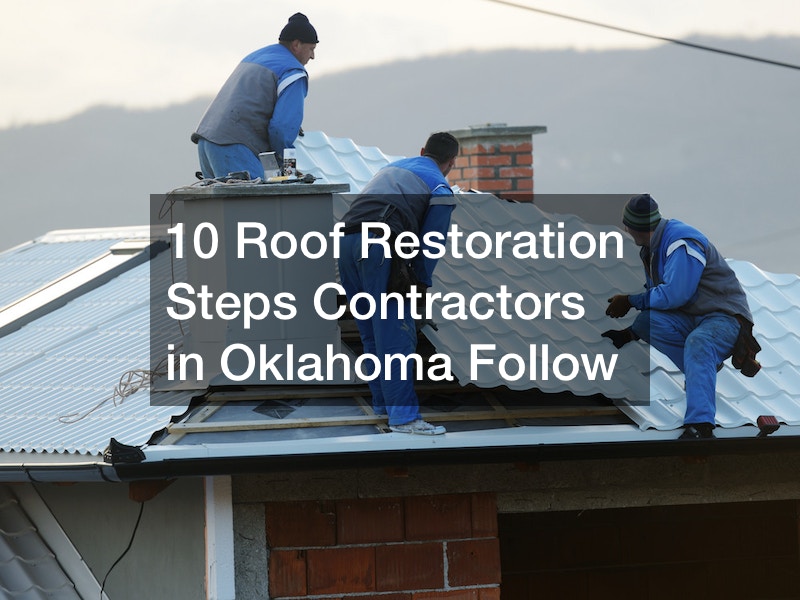The roof of a home is a critical component, providing protection from the elements and contributing to the overall structural integrity of the building. Over time, roofs can suffer from wear and tear, necessitating repairs to ensure continued performance. While complete roof replacement is sometimes necessary, there are situations where a roof repair is more economical and practical. This process involves repairing or replacing only the damaged sections of the roof, thus preserving the undamaged areas and reducing costs. In this detailed article, we will explore every aspect of partial roof repair, from assessing damages to finalizing the repair process. Through understanding each step, homeowners can make informed decisions, resulting in a durable and safe roof over their heads.
Assessing the Damage

Before initiating a roof repair, it is crucial to accurately assess the extent of the damage. This involves inspecting the roof thoroughly to identify any underlying issues that may not be immediately visible. Common signs that a roof may need repair include missing or damaged shingles, leaks, and water stains on ceilings that indicate moisture problems.
Roof repair is an essential task, ensuring small issues do not escalate into significant structural problems. During the inspection, it’s important to focus on areas that are more susceptible to damage, such as around chimneys, vents, and gutters. Identifying whether a full or partial repair is needed will guide the next steps in the restoration process.
Partial roof repairs are often the preferred choice when damage is localized. This approach saves money and time since it avoids unnecessary work on unaffected areas. Once the extent of the damage is determined, homeowners can proceed to engage a local roofer for expert advice and a professional assessment.
Hiring the Right Contractor
Engaging the services of a skilled local roofer is paramount for conducting effective roof repairs. A qualified contractor brings experience and expertise, which are crucial for ensuring the job is done correctly and efficiently. When selecting a contractor, it’s beneficial to look for those who have a proven track record within the community.
Consideration should be given to local roofing contractors familiar with the specific materials and climatic conditions of the area. This knowledge contributes to a more tailored repair approach, often leading to better outcomes. Furthermore, local contractors can provide faster service responses, a critical factor in preventing further damage, especially in critical situations.
It is also important to cross-verify the credentials of potential roofers, including their licenses and insurance. This step not only guarantees quality workmanship but also protects homeowners from liability in case of accidents during the repair process. Done right, hiring the right contractor lays the foundation for successful and lasting partial roof repairs.
Gathering Estimates for the Job
Once the damage has been assessed and a suitable contractor found, the next step involves gathering estimates for the roof repair . Requesting quotes from multiple local roofing contractors is a recommended practice. This allows homeowners to compare prices and services, ensuring they select a proposal that balances cost with quality. Additionally, it provides an opportunity to gauge the professionalism and communication style of different contractors, which can impact the overall project experience.
During the estimation process, contractors will often visit the site to provide a more accurate quote, taking into consideration factors such as the size of the area needing repair, the materials required, and the complexity of the job. They may also suggest additional work or improvements based on their expertise. It’s vital for homeowners to communicate their specific needs and any budget constraints at this stage to avoid misunderstandings later on.
Obtaining comprehensive estimates is crucial for planning and budgeting. It also helps to identify any potential additional costs that might not be immediately apparent, such as disposal fees or hidden damage that could be discovered once repairs begin. Ultimately, transparent and thorough estimates contribute to a smoother repair process, reducing the possibility of unexpected surprises mid-project. The more detailed the quote, the better prepared homeowners will be for the financial commitment involved.
Budgeting for the Repair

After acquiring estimates from various roof repair companies, the next step is to prepare a budget for the partial roof repair. Budgeting involves not only considering the direct costs of materials and labor but also allocating funds for potential contingencies. Unexpected expenses may arise, such as further damage discovered during repairs or a sudden increase in material costs.
While roof repair can be a cost-effective alternative to a full replacement, wise financial planning is crucial. Homeowners should aim to set aside a reserve fund to cover any additional expenses that might not have been initially accounted for. This ensures that repairs are not halted due to unforeseen financial constraints.
It’s also beneficial to explore different payment options offered by roof repair companies. Some may provide financing plans or discounts for larger jobs. Understanding these options can ease the financial burden and make the repair process more manageable.
Choosing Compatible Roofing Materials
Selecting the appropriate roofing material is an important decision in the roof repair process. Different materials, such as asphalt shingles, tiles, or metal, each come with distinct advantages and drawbacks. Choosing materials that blend well with the existing roof is essential for ensuring visual consistency and structural integrity. Additionally, the selected materials should align with the home’s architectural style to maintain curb appeal.
Metal roofing services are popular for their durability and longevity, often resulting in reduced long-term maintenance costs. Asphalt shingles, on the other hand, are affordable and versatile, making them a common choice for many homeowners. When considering material options, homeowners should balance aesthetic preferences with practical considerations like climate suitability and cost efficiency. Taking the time to research materials can prevent future issues and unnecessary expenses.
Compatibility in material choices helps maintain a uniform appearance and functionality. The expertise of local roofers can be invaluable in this decision-making process. Their familiarity with regional building codes and weather conditions will guide homeowners in choosing the most appropriate materials for their partial roof repair. Consulting with professionals ensures the materials are installed correctly and provide optimal performance. This foresight contributes to a successful outcome and a roof that stands the test of time.
Preparing Your Home for Repairs
Proper preparation before commencing any roof repair is crucial for safety and efficiency. Protecting the interior of the home from dust and debris is a key concern. Homeowners can take measures like covering furniture and valuables to mitigate potential damage during repairs.
Residential roofers often recommend clearing the surroundings of the house to allow easy access to the roof. This includes trimming overhanging branches and removing items that might obstruct the safety and movement of workers. Such preparations ensure a smoother workflow and minimize disruptions to everyday life.
Homeowners should also communicate with their families or other residents about the schedule and scope of the impending repairs. This enables everyone to anticipate noise levels and any interruptions to utilities that might occur. Being well-prepared mitigates inconveniences and contributes to a more seamless repair process.
Discussing the Project Timeline

A clear project timeline is essential for managing expectations and ensuring that repairs are completed promptly. When engaging with siding companies and other contractors, homeowners should discuss and agree upon realistic timelines. This helps prevent misunderstandings and miscommunications throughout the project, keeping everyone on the same page.
The complexity of the partial roof repair, weather conditions, and the availability of materials are some factors that can affect the timeline. By understanding these variables, homeowners can work collaboratively with the contractor to achieve timely completion. Regular communication is key to managing delays and addressing any issues that arise, ensuring the project stays on track.
Having a well-defined project timeline also assists homeowners in planning their daily lives around the repair work. It ensures that everyone involved, from the contractor to the homeowner, is aligned toward a common goal, ultimately leading to a successful roofing project. Furthermore, it allows homeowners to schedule additional services, like gutter maintenance or inspections, more effectively. Proper planning minimizes disruptions and helps avoid last-minute adjustments. By keeping the timeline in focus, homeowners can better prepare for any unexpected changes while still maintaining the overall repair schedule.
Understanding the Repair Process
Comprehending the steps involved in partial roof repair aids homeowners in better managing the process. Generally, the repair begins with removing any damaged roofing material. This allows for the inspection of the underlying structure for any unseen damage.
Once the damaged materials are removed, metal roofers or other specialists repair any issues with the roof deck before installing new materials. This step is critical to ensuring the roof’s structural integrity and waterproofing are restored. Using high-quality materials can enhance the durability and longevity of the repairs.
Clear communication with the contractor is crucial throughout this process. Homeowners should feel empowered to ask questions and seek clarifications on the methods used, ensuring that the repair aligns with their expectations and standards.
Inspecting the Completed Work
After the repair work is completed, a thorough inspection should be conducted to ensure all elements meet quality standards. Homeowners can perform a preliminary inspection themselves, checking for visual consistency and any signs of leftover damage or improper installation. Look closely at shingles, flashing, and gutters to verify proper alignment and function.
Employing the services of a gutter cleaning company or other specialist may also be beneficial. These professionals can provide a detailed assessment of water flow and potential blockages that might have arisen during construction. Such inspections validate the efficacy of the roof repairs completed and help prevent future water damage or drainage issues.
Ensuring that the contractor has addressed all aspects of the agreed-upon project scope is critical. This includes checking that all materials used match what was outlined in the contract. A comprehensive inspection confirms that the partial roof repair has been implemented successfully, safeguarding the home’s integrity, improving durability, and providing peace of mind for its inhabitants.
Requesting a Warranty
A warranty provides peace of mind, protecting homeowners against defects in materials or workmanship that might only become apparent after the repair. Flat roofers and other contractors often offer warranties as part of their service, which should be discussed early in the project.
Understanding the terms and conditions of the warranty can prevent future disputes. Homeowners should inquire about specific coverage details, such as the duration and what repair aspects are included. It is important to have these documents in writing and stored safely for future reference.
A robust warranty reflects the confidence a contractor has in their work. By securing a warranty, homeowners ensure long-term returns on their investment, knowing that their partial roof repairs are supported and protected.
Maintaining the Roof After Repairs

Post-repair maintenance is essential in prolonging the lifespan of a roof. Regular inspections and cleaning can prevent minor issues from escalating into significant problems. Homeowners should inspect the roof seasonally for any signs of damage, especially after severe weather events. This proactive approach can catch issues early before they become costly to fix.
Scheduled maintenance services from a gutter cleaning company or a local roofer can help keep the roof in optimal condition. These professionals offer targeted solutions to prevent water damage, debris buildup, and other common roofing issues. Consistent maintenance preserves the integrity and functionality of the roof while enhancing its durability over time.
In addition, promptly addressing any new damage with a partial roof repair approach can prevent more extensive repairs or replacements. Pairing this with routine maintenance helps identify weak spots and reinforces vulnerable areas. Staying proactive in maintaining the roof extends its life, enhances curb appeal, and ensures continued protection for the home and its inhabitants.
Partial roof repair is a practical solution for addressing damage while preserving the integrity and aesthetics of the home. Throughout this article, we have explored the steps involved in undertaking such repairs, from assessing damage and hiring contractors to selecting materials and maintaining the completed work. By following these outlined procedures, homeowners can successfully navigate the complexities of roof repair. Engaging the expertise of local roofers and roofing contractors not only enhances the repair outcomes but also ensures that the home’s protective envelope remains robust against the elements. Through informed decision-making and diligent maintenance, the longevity and performance of the roof can be maximized, providing peace of mind and security for years to come.





